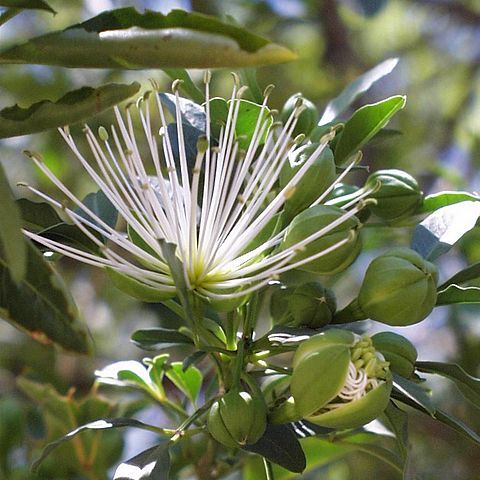It can be a low bush or a medium sized tree. It grows 4.5-9 m tall. The trunk is usually light coloured and mottled. The leaves are compound with 3-5 leaflets. These leaflets are oval and 8 cm long and about 2.5 cm wide. They have a pointed tip. The flowers are white and scented. They are large and have long stamens with green tips. They occur in clusters near the ends of branches. The fruit are oval or funnel shaped. They are about 4.5 cm long. They have a thick rind and are smooth and slightly ribbed. They are carried on thick stalks. They have many round seeds. The fruit is edible.
Tree or shrub, 1.5-9.0 m high; bark white, mottled; younger branches yellowish or grey-green, lenticels conspicuous. Leaves petiolate, chartaceous to coriaceous, glabrous; 3(-5)-foliate, leaflets elliptic or obovate, median leaflet longer than laterals. Inflorescence terminal corymbs, 3-12 flowered, pedicellate. Receptacle infundibular, margins entire or scalloped. Sepals 4, ovate, margins ciliate. Petals absent. Stamens 30-45. Ovary ellipsoid to oblong. Flowering time May-Dec. Fruit oblong-ellipsoid, smooth to faintly colliculate. Seeds subglobose, verrucose.
Glabrous shrub or small tree up to 4 m. tall very like M. nervosa superficially but differs in the following ways: the leaflets are often acute or acuminate rather than rounded at the apices, the venation is not reticulate or prominent below; the receptacle is c. 4 mm. long and widens gradually to a diameter of 4 mm. at the mouth and lacks quadrate lobes; the sepals are narrowly ovate-acuminate and up to 2 x 1 cm.; the petals are absent; the androgynophore is not or barely exserted; the stamens are 35–40; the fruit reaches 4.5 x 2.7 cm.
Shrub or tree, up to 9 m high. Leaves 3-5-foliolate; leaflet apex acute to rounded, veins immersed. Inflorescence corymbose at ends of branches. Petals 0. Fruit oblong-ellipsoid, up to 45 x 33 mm. Flowers white.
Shrub or tree with mottled bark, to 9 m. Leaves digitately 3(-5)-foliolate. Flowers in terminal corymbs, greenish.


